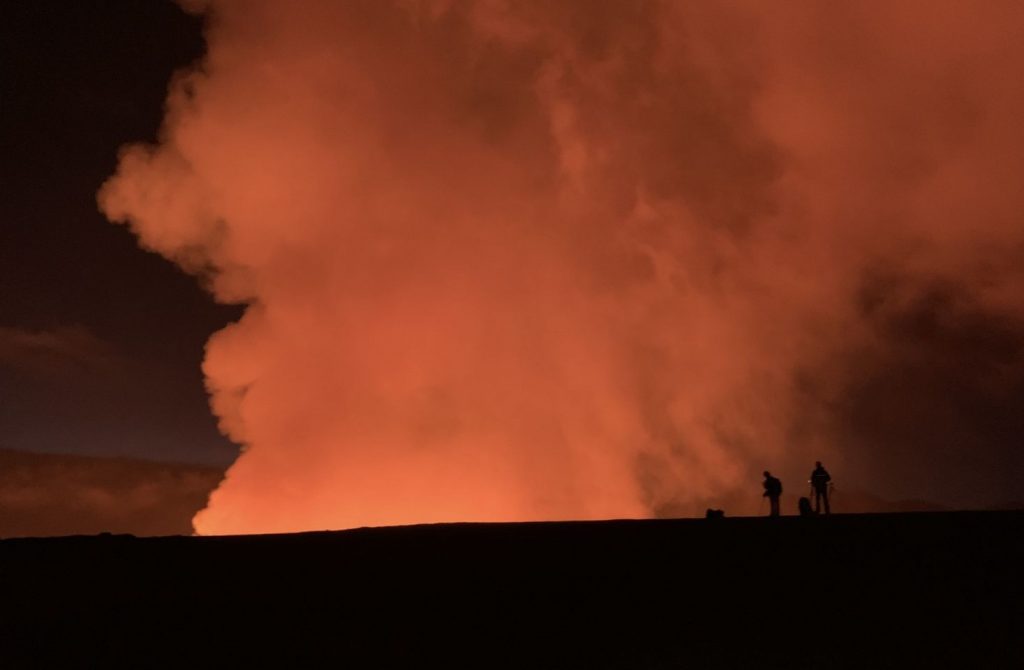Update 2: Kīlauea eruption still confined to Halemaʻumaʻu crater; fountain heights now 13-30 feet

Story updated with new information at 6 p.m. on June 7, 2023:
Halemaʻumaʻu Crater at the summit of Kilauea volcano is erupting, producing a burst of volcanic emissions starting at 4:44 a.m. Wednesday morning, according to the USGS Hawaiian Volcano Observatory.
At 3 p.m. on Wednesday, multiple minor fountains are active on Halema‘uma‘u crater floor of Kīlauea. One fissure remains active on the southwest wall of the caldera.
Fountain heights have decreased since the eruption onset and are now about 13 to 30 feet high. Initial lava flows inundated the crater floor (an area of approximately 370 acres) and added about 32 feet depth of new lava.
A ring of elevated 3 to 6 feet lava surrounds the perimeter of the crater floor (like a bathtub ring), encircling continued lava flow activity across the crater floor.
As of 9 a.m. on Wednesday, no unusual activity has been noted along Kīlauea’s East Rift Zone or Southwest Rift Zone, with the eruption contained within Halemaʻumaʻu Crater and entirely within Hawai’i Volcanoes National Park. That remained the case through Wednesday evening.
Multiple minor fountains were active in the central eastern portion of the crater floor and one vent is open on the west wall of the caldera, within the closed area of Hawai’i Volcanoes National Park. During the dynamic early phase of the eruption, fountain bursts reached at least 200 feet.
To watch the eruption live, click here.
Kīlauea’s last eruption lasted 61 days and ended on March 7. Hawai’i Volcanoes National Park posted on its Facebook page at the time: “Pele is taking a break.”
But Pele’s break was over early Wednesday morning when scientists observed the eruption on infra-red satellite imagery. Radar indicates winds will cause any ash emissions to drift towards the west-southwest direction this morning.
Kīlauea’s alert level early Wednesday morning was raised from watch to warning and its aviation color code from organge to red as this eruption and associated hazards are evaluated.
Volcanic gas emissions in the eruption area are elevated; a sulfur dioxide (SO2) emission rate of approximately 65,000 tonnes per day was measured between approximately 8 and 9 a.m. Wednesday morning. Residents of Pāhala, 20 miles downwind of Kīlaueaʻs summit reported a very light dusting of gritty fine ash and Peleʻs hair Wednesday morning.

High levels of volcanic gas are the primary hazard of concern, as this hazard can have far-reaching effects down-wind. Large amounts of volcanic gas — primarily water vapor (H2O), carbon dioxide (CO2), and sulfur dioxide (SO2) — are continuously released during eruptions of Kīlauea volcano.
As sulfur dioxide is released from the summit, it will react in the atmosphere to create the visible haze known as vog (volcanic smog) that has been observed downwind of Kīlauea. Vog creates the potential for airborne health hazards to residents and visitors, damages agricultural crops and other plants, and affects livestock
Additional hazards include Pele’s hair and other lightweight volcanic glass fragments from the lava fountains that will fall downwind of the fissure vents and dust the ground within a few hundred meters (yards) of the vent (s). Strong winds may waft lighter particles to greater distances. Residents should minimize exposure to these volcanic particles, which can cause skin and eye irritation.
Other significant hazards also remain around Kīlauea caldera from Halemaʻumaʻu crater wall instability, ground cracking, and rockfalls that can be enhanced by earthquakes within the area closed to the public. This underscores the extremely hazardous nature of Kīlauea caldera rim surrounding Halemaʻumaʻu crater, an area that has been closed to the public since late 2007.
For discussion of Kīlauea hazards, click here.

For Hawaiʻi Volcanoes National Park visitor information, click here.
Visitors to Hawaiʻi Volcanoes National Park should note that under southerly (non-trade) wind conditions, there is potential for a dusting of powdery to gritty ash composed of volcanic glass and rock fragments. These ashfalls represent a minor hazard, but visitors should be aware that such dustings at areas around the Kīlauea summit are possible.
Avoid excessive exposure to ash which is an eye and respiratory irritant. Those with respiratory sensitivities should take extra precaution to minimize exposure.
For more information on the status of Kilauea Volcano, click here.
For health and safety recommendations, visit the Hawaii
Interagency Vog Information Dashboard.
Sponsored Content
Comments
















